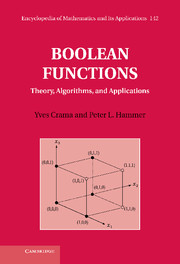C - JBool: A software tool
Published online by Cambridge University Press: 01 June 2011
Summary
Introduction
JBool is an application designed for teaching and illustrative purposes. It allows users to work with Boolean functions in disjunctive normal form (DNF) or in conjunctive normal form (CNF), and to easily manipulate the concepts described in this book or test conjectures on small-size examples. It is not an industrial software package, and it is not optimized to tackle large problems.
JBool can be downloaded freely from http://hdl.handle.net/2268/72714. The user interface is written in Java and the core engine for Boolean functions is written in ANSI C. The Java application requires a Java Runtime Environment (JRE) 1.3 or later, and binaries for the engine are available for the following platforms:
Mac OS 10.3 and later
Windows XP and later
Linux x86
Source code is available, so the engine can be compiled for other platforms as well.
This appendix is organized as follows. First, the basic interface of the software is presented in Section C.2. The tools available to create, load, or save a function are described in Section C.3. The main functionalities of the software are then successively examined: Modify the elements of the edition (Section C.4), create several representations of the same function (Section C.5.1), apply various operators to the current function (Section C.5.2), perform operations on several functions and test properties of the current function (Section C.5). More details on all these functionalities can be found in the on-line help of the software.
Work interface
Figure C.1 displays the work interface of JBool. The main elements of this interface are described in the following sections.
- Type
- Chapter
- Information
- Boolean FunctionsTheory, Algorithms, and Applications, pp. 627 - 634Publisher: Cambridge University PressPrint publication year: 2011



